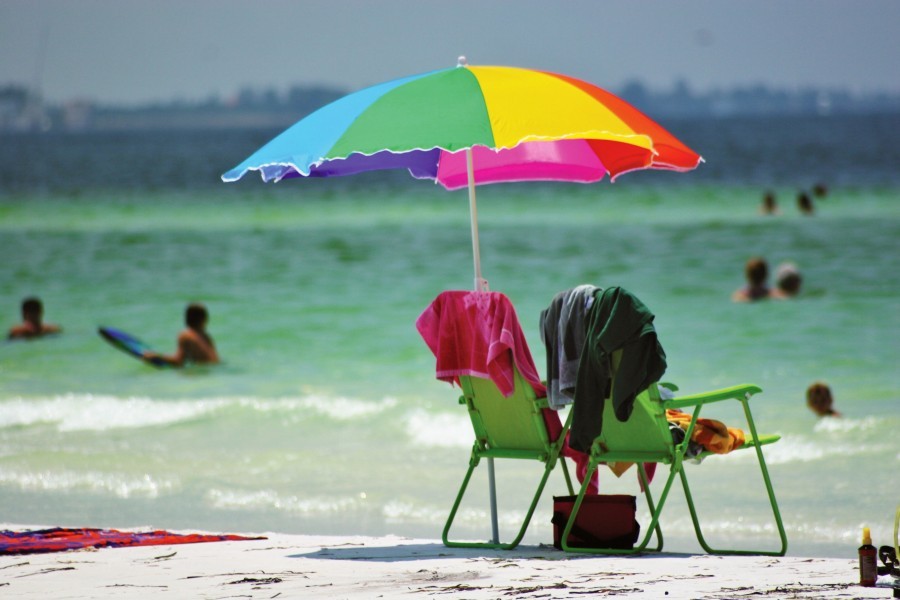Mote scientists expand beach monitoring service for Florida residents and visitors
During this year of record Florida tourism, Mote Marine Laboratory scientists are announcing exciting upgrades to their real-time beach monitoring tool — giving visitors and residents improved resources to plan a safe and fun day at the beach.
Mote’s Beach Conditions Reporting System (BCRS) provides twice-daily, online updates about conditions at 27 of Florida’s Gulf Coast beaches. The site is updated by trained volunteers, such as lifeguards and park rangers, using smartphones. The BCRS web site was launched by Mote in 2006 to help beachgoers avoid the effects of naturally occurring Florida red tide algae, and since then it has incorporated many other kinds of beach information, such as wind direction, surf height and rip current monitoring. The site has also grown in popularity — since the updated BCRS launched on Nov. 15, the site has hosted almost 7,300 users with 574 page views per day on average. The highest count during this period was 870 views per day. Users hail from as far away as Japan, Australia and Europe.
Now, using public survey results gathered in June and July 2015, Mote has rolled out a more user-friendly BCRS web site that is mobile responsive and adds several new types of information. Mote scientists invite the public to check it out and enjoy its benefits. Mote is also seeking sponsorships from tourism agencies, municipalities and beach-related businesses to further expand the reach and benefits of the BCRS.
Funding for upgrading and maintaining Mote’s BCRS is provided by local agencies and businesses that understand the need for environmental-monitoring and outreach services for residents and tourists. In particular, Mote is working hard with its partners to increase support for all of the Lab’s monitoring and research efforts related to Florida red tide, including BCRS and the Cooperative Red Tide Research Initiative – a partnership between Mote and the Florida Fish and Wildlife Conservation Commission. BCRS receives no state funds, and state funds for the cooperative initiative decreased from $2.2 million in 2014 to $1.6 million this year. Both efforts provide crucial and complementary public information about the presence and impacts of Florida red tide. (More about BCRS sponsorship opportunities below.)
The new, enhanced BCRS site was designed by Mote’s Environmental Health Program in collaboration with Function on Phones, the web developer contracted by Mote researchers to build the site.
- See the new BCRS at www.visitbeaches.org. The original address (www.mote.org/beaches) redirects to the new site. BCRS updates are also available via phone message. Call 941-BEACHES.
“With this upgraded site, we are providing more of the information that any Florida beachgoer would want, any time of the year,” said Dr. Tracy Fanara, manager of Mote’s Environmental Health Program. “We’re trying to make this a one-stop shop, whether you’re looking for updates on Florida red tide effects or other beach information. For instance, our survey results showed that many people want updates on parameters such as weather, water temperature and crowds; therefore we added those features to the new site.”
Thanks to 89 survey responses from the general public and stakeholders such as county tourism agencies, the new BCRS web site adds details about weather conditions, water and air temperature, crowds, jellyfish, beach debris (to help visitors gauge cleanliness of the beach) and more. The site also retains its original categories of information, which were generally valued by survey responders. Indicators of Florida red tide (respiratory irritation among beachgoers and sightings of dead fish) were the highest-valued, followed closely by rip current monitoring. Soon the BCRS site will also add timing of sunset, sunrise and tides.
The upgraded site is easier to use because it is mobile responsive for better viewing on smartphones. It also offers the new option to search by beach name, city or county — a helpful feature for Florida visitors who might know only partial geographic information.
User-friendly beach monitoring services are more important than ever, given that a record-breaking 79.1 million people visited Florida during the first nine months of 2015.
While many municipalities, tourism agencies or other beach-related authorities participate in BCRS by arranging for volunteers to provide updates, Visit Sarasota County and the Lee County Visitor & Convention Bureau are providing much-needed funds for BCRS to operate and expand by sponsoring their beach listings. Sponsored listings feature promotional photos of the beaches and list their amenities — such as shower facilities, dog-friendly areas and snorkeling highlights — on the BCRS web site. Survey results indicate that beachgoers highly value amenity information.
Mote, an independent nonprofit marine Lab, depends on support from its communities to provide valuable public services such as the BCRS. Mote scientists encourage municipalities, tourism agencies and other beach-related authorities to consider a paid listing on the BCRS site — an excellent way to support tourism and give back to the community. In addition, beach-related businesses are welcome to contact Mote to discuss sponsorship opportunities and benefits.
Municipalities, tourism agencies and businesses seeking to sponsor BCRS can contact Tracy Fanara at tfanara@mote.org or 941-302-2046.
Stay tuned: Mote scientists expert to release a BCRS smartphone app in early 2016.
